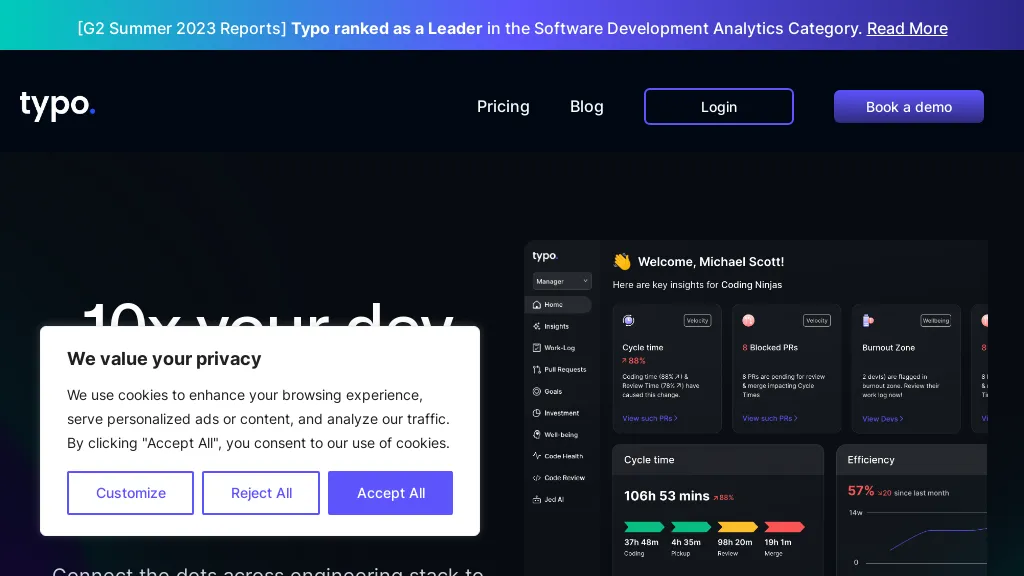What is Typo?
Typo is an enhanced engineering analytics platform for development teams to write higher grade code, increase deployment processes, and improve business impact. On those dimensions, it focuses on improving the velocity, quality, throughput, and general well-being of development teams.
By leveraging different layers of the engineering stack, Typo ensures teams are aligned to business goals and deliver quickly without ever letting quality slip. It gives troubled details of all the efforts and costs spent on innovation, the technical debt, and the roadmaps so that one can work out the drivers of SDLC metrics to help with the improvement of development efficiency and provide real-time blocker takeout. Typography also shapes a culture that drives productivity to the nth level, improving the experience and well-being of your developers.
Typo’s Key Features & Benefits
Typo offers a wide range of features and benefits that make it lucrative for a wide category of users. Key among them include:
- Measure effort and cost spent on innovation
- Tracking technical debt
- Manage and optimize roadmaps
- Identify SDLC metrics impacting development efficiency
- Remove blockers in real-time
By leveraging these features, teams can gain deep insights, improve work culture, and achieve personalized recommendations for areas of improvement. Moreover, the platform enhances code quality, optimizes business impact, and helps balance workload distribution to enable managers to deliver faster without compromising on quality. Developers will benefit by gaining visibility into how their work impacts overall team efficiency and goals.
Typo’s Use Cases and Applications
Typo finds varied use in several industries and specific scenarios. Some of the leading use cases include:
- Calculate effort and expense
- Improve the culture of work
- Give personalized recommendations
- Improve the quality of code
- Optimization of business impact
These use cases made Typo a great fit for sectors such as software engineering, project management, and DevOps. Some of the leading user groups that are using Typo are software engineers, engineering managers, IT project managers, DevOps engineers, and CTOs.
Typo is quite easy to use and highly user-friendly. Below are a few how-tos:
- Sign up for a free trial on the Typo website.
- Set up the Typo with your dev tools and workflows; it could be Slack, for automated dev workflows.
- Start taking an interest in a few key metrics and receiving real-time insights and some recommendations.
- Extract powerful insights from the new dashboards of the platform about your effort, cost, and technical debt.
- Go actionable and start unblocking or removing some friction to make the team efficient.
For best results, feed in your development processes regularly to customize the recommendations provided. Intuitive user interface for easy navigation and utilization of features.
How Typo Works
Typo is driven by state-of-the-art algorithms and models, gathering and parsing engineering data across the stack. The platform leverages machine learning to uncover patterns in the operations of the system. Normally, the workflow starts with data collection moving to the analytics of metrics, hence issuing real-time recommendations that can be put into practice without a hitch, thus improving the development pace and wellness of the team.
The technical overview goes down to tools integration during development, automated management of workflows, and personalized suggestions based on continuous data analysis that guides team decision-making, hence ensuring teams are always aligned with business needs while continuously improving.
Pros and Cons of Typo
Like any other tool, Typo has numerous benefits and a few potential downsides. Here’s what you need to know about its pros and cons:
Pros:
- Improved code quality and faster deployment
- Better team alignment to business objectives
- Actionable recommendations through real-time insights
- Cultivates a productive work culture and developer well-being
- Integrates with popular development tools like Slack
Possible Limitations:
- May require at least some setup/integration time onboarding
- Cost might be prohibitive for smaller teams
- A new member to the team has to be educated on how to use the system
Generally, user feedback shows that the platform can really improve the development efficiency and well-being of the team. However, it takes some time to integrate all features and get the most out of the product.
Conclusion on Typo
Typo is an all-in-one analytic engineering platform that effectively increases the efficiency of any development team, the quality of the code produced, and by this, the general well-being of a company. Powerful features, real-time insights, and unique recommendations make it a handy product for a lot of user groups, from software engineers to CTOs. It abounds in weaknesses that are likely to be enumerated below, but most of its important strengths outweigh the insignificant negatives that may itch your team to close the gap and fuel continuous improvement in your business.
Future developments and updates will make the platform even more worthy for investment by a development team, as it offers numerous advanced capabilities.
Typo FAQs
What is Typo?
Typo is an engineering analytics platform geared towards making code quality better, deploying faster, and improving your development team’s overall well-being.
Who will benefit directly from using Typo?
Directly benefiting from the use of Typo will be software engineers, engineering managers, IT project managers, DevOps engineers, and CTOs.
What pricing plans does Typo offer?
Typo has a freemium model, a Pro plan at $15 per developer per month, and an Enterprise plan priced according to the customer’s needs.
How is development efficiency improved by Typo?
Typo supports real-time insights and measurement of effort, cost, and technical debt. Personalized recommendations for blockers to increase team efficiency are provided.
Is Typo difficult to learn?
There is no serious learning curve with Typo; however, during initial setup and while integrating with third-party services, it might be a bit challenging.










